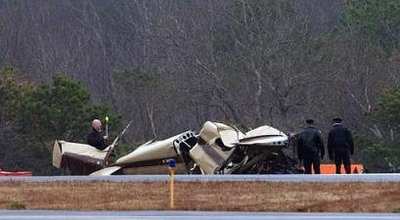A Compendium Of In-Flight And Take-Off Issues Left Two
Dead
The NTSB says it was a multitude of errors that led to a fatal
midair just above the runway at Westerly Airport in Rhode Island.
Two CFIs were killed in the November 16, 2003 mishap.

It happened at about 1330 local, when the pilots of Piper PA-28
and a Cessna 180 tried to occupy the same airspace at the same
time, according to the NTSB report:
According to the pilot of the Piper, when he arrived in the
Westerly Airport area, a landing attempt was made to runway 32;
however, because he was too high on the approach, the pilot elected
to abort the landing. The pilot remained in the left-hand traffic
pattern for runway 32, and announced all of his positions during
the traffic pattern on the Common Traffic Advisory Frequency
(CTAF).
Upon turning final approach to land the second time, the pilot
observed a tail-wheeled airplane "about to get onto runway 32." The
airplane remained on the displaced threshold portion of the runway,
and the pilot thought it would remain there until after he landed.
The pilot continued the approach, and soon after he passed over the
runway threshold, he heard the sound of another airplane's engine,
followed by an impact with the airplane.
The pilot observed the other airplane descend towards the
ground, as he performed a forced landing to the runway. The Piper
touched down hard on the runway, collapsing the right main landing
gear assembly. The airplane continued down the runway, and began to
veer to the right, where it struck a taxiway light, before coming
to rest upright on a taxiway.

The NTSB finding of probable cause pointed out that the pilot of
the Cessna was never heard to announce his intentions over the
airport's CTAF.
The pilot of the Piper did not recall hearing the Cessna make
any transmissions on the CTAF frequency, but did recall hearing
other aircraft make transmissions. Examination of the approach end
area of the runway revealed trees, which paralleled the taxiway
leading up to runway 32, visually obscured aircraft flying
left-hand traffic patterns for the runway.
Traffic in the air was not visible to an individual facing
southeast until the traffic turned onto final approach. According
to the Aeronautical Information Manual, paragraph 4-1-9. Traffic
Advisory Practices at Airports Without Operating Control Towers,
"Pilots of departing aircraft should monitor/communicate on the
appropriate frequency from start-up, during taxi, and until 10
miles from the airport..." According to Federal Aviation
Regulations Part 91.113, Right-of-way rules, "Aircraft, while on
final approach to land or while landing, have the right-of-way over
other aircraft in flight or operating on the surface...

The conclusion? According to the NTSB:
The Piper pilot's improper decision to continue a landing on an
occupied runway, which resulted in an in-flight collision with the
departing Cessna. Factors related to the accident were the
departing Cessna pilot's inattentive radio communications, and the
obscured visibility of the traffic pattern from the air and ground
by trees located at the departure end of the runway.
There's a footnote to this story. The FAA recently
announced a $3.6 million grant for Westerly. It includes funds for
improving the runway and removing trees that obscurred the end of
the strip from aircraft approaching from the southeast.
 ANN's Daily Aero-Term (04.28.24): Airport Marking Aids
ANN's Daily Aero-Term (04.28.24): Airport Marking Aids Aero-News: Quote of the Day (04.28.24)
Aero-News: Quote of the Day (04.28.24) ANN's Daily Aero-Linx (04.28.24)
ANN's Daily Aero-Linx (04.28.24) Aero-News: Quote of the Day (04.29.24)
Aero-News: Quote of the Day (04.29.24) ANN's Daily Aero-Linx (04.29.24)
ANN's Daily Aero-Linx (04.29.24)





